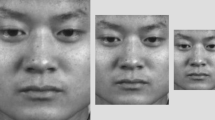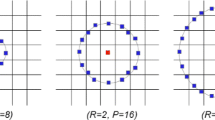Abstract
The interest in real-time micro-expression recognition has increased with the current trend in human-computer interaction applications. Presently, there are several approaches which include geometrical analysis for fast facial muscle movement feature representations. However, due to the subtleness of emotions, recognition accuracy remains a challenge in this field. In order to address this challenge, this paper put forward a novel geometrical-based invisible emotion magnification algorithm (IEMA). This algorithm utilizes facial landmarks of on-set and apex frames to compute magnication elements as well as the direction of facial movement, and then applies them to the x and y coordinates of the apex-frame to enhance the magnitude of facial muscle movement for invisible emotion. Furthermore, this algorithm integrates a parameter which is set to adjust the magnification level in order to achieve optimal performance. The proposed IEMA was analyzed using a landmark-based facial graph, and subsequently, the euclidean distance and gradient of the graph segments were presented as features. The experimental results suggest that the proposed IEMA yields the highest accuracy of 94.78% and an F1-score of 0.90 with the CASMEII dataset, while the SMIC, CAS(ME)\(^2\) and SAMM datasets yield accuracies of 87.98%, 88.89% and 94.72% with F1-score of 0.86, 0.83 and 0.88, respectively. In fact, the proposed IEMA outperformed several micro-expression magnification methods in terms of accuracy as well as the F1-score. In addition, the proposed IEMA running time is 3.41ms per sample, which translates to 293 fps. This suggests that the proposed IEMA processes samples above the minimum requirement of 200fps for micro-expression recognition in real-time.







Similar content being viewed by others
References
Bergstra J, Bengio Y (2012) Random search for hyper-parameter optimization. J Mach Learn Res 13:2
Bowyer A (1981) Computing dirichlet tessellations. Comput J 24(2):162–166
Buhari AM, Ooi C-P, Baskaran VM, Phan RC, Wong K, Tan W-H (2020) Facs-based graph features for real-time micro-expression recognition. J Imaging 6(12):130
Chaudhry R, Ravichandran A, Hager G, Vidal R (2009) Histograms of oriented optical flow and binet-cauchy kernels on nonlinear dynamical systems for the recognition of human actions. In 2009 IEEE Conference on Computer Vision and Pattern Recognition, pp. 1932–1939
Datta S, Sen D, Balasubramanian R (2017) Integrating geometric and textural features for facial emotion classification using svm frameworks. In Proceedings of International Conference on Computer Vision and Image Processing. Springer, pp. 619–628
Davison A, Merghani W, Lansley C, Ng C-C, Yap MH (2018) Objective micro-facial movement detection using facs-based regions and baseline evaluation. In 2018 13th IEEE International Conference on Automatic Face & Gesture Recognition (FG 2018), pp. 642–649
Davison AK, Lansley C, Costen N, Tan K, Yap MH (2018) Samm: A spontaneous micro-facial movement dataset. IEEE Trans Affect Comput 9(1):116–129
Davison AK, Yap MH, Lansley C (2015) Micro-facial movement detection using individualised baselines and histogram-based descriptors. In 2015 IEEE International Conference on Systems, Man, and Cybernetics, pp. 1864–1869
Ekman P (2012) Emotions revealed: Understanding faces and feelings. Hachette UK
Ekman R (1997) What the face reveals: Basic and applied studies of spontaneous expression using the Facial Action Coding System (FACS). Oxford University Press, USA
Esmaeili V, Shahdi SO (2020) Automatic micro-expression apex spotting using cubic-lbp. Multimedia Tools and Applications, pp. 1–19
Feng Z-H, Kittler J, Awais M, Huber P, Wu X-J (2017) Face detection, bounding box aggregation and pose estimation for robust facial landmark localisation in the wild. In Proceedings of the IEEE Conference on Computer Vision and Pattern Recognition Workshops, pp. 160–169
Gan Y, Liong S-T, Yau W-C, Huang Y-C, Tan L-K (2019) Off-apexnet on micro-expression recognition system. Signal Process Image Commun 74:129–139
Golzadeh H, Faria DR, Manso LJ, Ekárt A, Buckingham CD (2018) Emotion recognition using spatiotemporal features from facial expression landmarks. In 2018 International Conference on Intelligent Systems (IS), pp. 789–794
Hong X, Xu Y, Zhao G (2016) Lbp-top: a tensor unfolding revisit. In Asian Conference on Computer Vision, Springer, pp. 513–527
Jeong M, Ko BC (2018) Driver’s facial expression recognition in real-time for safe driving. Sensors 18(12):4270
Kazemi V, Sullivan J (2014) One millisecond face alignment with an ensemble of regression trees. In Proceedings of the IEEE Conference on Computer Vision and Pattern Recognition, pp. 1867–1874
King DE (2009) Dlib-ml: A machine learning toolkit. J Mach Learn Res 10:1755–1758
Kumar AJR, Theagarajan R, Peraza O, Bhanu B (2019) Classification of facial micro-expressions using motion magnified emotion avatar images. In CVPR Workshops, pp. 12–20
Lai Z, Chen R, Jia J, Qian Y (2020) Real-time micro-expression recognition based on resnet and atrous convolutions. J Ambient Intell Humaniz Comput, pp. 1–12
Le Ngo AC, Oh Y-H, Phan RC-W, See J (2016) Eulerian emotion magnification for subtle expression recognition. In 2016 IEEE International Conference on Acoustics, Speech and Signal Processing (ICASSP), pp. 1243–1247
Lee Z-C, Phan RC-W, Tan S-W, Lee K-H (2017) Multimodal decomposition for enhanced subtle emotion recognition. In 2017 Asia-Pacific Signal and Information Processing Association Annual Summit and Conference (APSIPA ASC) IEEE, pp. 665–671
Li X, Hong X, Moilanen A, Huang X, Pfister T, Zhao G, Pietikäinen M (2018) Towards reading hidden emotions: A comparative study of spontaneous micro-expression spotting and recognition methods. IEEE Trans Affect Comput 9(4):563–577
Li X, Pfister T, Huang X, Zhao G, Pietikäinen M (2013) A spontaneous micro-expression database: Inducement, collection and baseline. In 2013 10th IEEE International Conference and Workshops on Automatic Face and Gesture Recognition (FG), pp. 1–6
Liong S-T, See J, Wong K, Phan RC-W (2016) Less is more: Micro-expression recognition from video using apex frame. Signal Process Image Commun 62:82–92
Liong S-T, Wong K (2017) Micro-expression recognition using apex frame with phase information. In 2017 Asia-Pacific Signal and Information Processing Association Annual Summit and Conference (APSIPA ASC), pp. 534–537
Oh Y-H, See J, Le Ngo AC, Phan RC-W, Baskaran VM (2018) A survey of automatic facial micro-expression analysis: Databases, methods and challenges. Front Psychol 9:1128
O’Sullivan M, Frank MG, Hurley CM, Tiwana J (2009) Police lie detection accuracy: The effect of lie scenario. Law Hum Behav 33(6):530
Park S, Kim D (2009) Subtle facial expression recognition using motion magnification. Pattern Recogn Lett 30(7):708–716
Pawar SS, Moh M, Moh T-S (2019) Micro-expression recognition using motion magnification and spatiotemporal texture map. In International Conference on Ubiquitous Information Management and Communication, Springer, pp. 351–369
Qu F, Wang S-J, Yan W-J, Li H, Wu S, Fu X (2018) Cas(me)\(^2\): A database for spontaneous macro-expression and micro-expression spotting and recognition. IEEE Trans Affect Comput 9(4):424–436
Soh XR, Baskaran VM, Buhari AM, Phan RC-W (2017) A real time micro-expression detection system with lbp-top on a many-core processor. In 2017 Asia-Pacific Signal and Information Processing Association Annual Summit and Conference (APSIPA ASC), pp. 309–315
Talukder BB, Chowdhury B, Howlader T, Rahman SM (2016) Intelligent recognition of spontaneous expression using motion magnification of spatio-temporal data. In Pacific-Asia Workshop on Intelligence and Security Informatics, Springer, pp. 114–128
Wadhwa N, Rubinstein M, Durand F, Freeman WT (2013) Phase-based video motion processing. ACM Trans Graph 32(4):1–10
Wang Y, See J, Oh Y-H, Phan RC-W, Rahulamathavan Y, Ling H-C, Tan S-W, Li X (2017) Effective recognition of facial micro-expressions with video motion magnification. Multimed Tools Appl 76(20):21665–21690
Wu H-Y, Rubinstein M, Shih E, Guttag J, Durand F, Freeman W (2012) Eulerian video magnification for revealing subtle changes in the world. ACM Trans Graph 31(4):1–8
Xia Z, Hong X, Gao X, Feng X, Zhao G (2019) Spatiotemporal recurrent convolutional networks for recognizing spontaneous micro-expressions. IEEE Trans Multimedia 22(3):626–640
Xu F, Zhang J, Wang JZ (2017) Microexpression identification and categorization using a facial dynamics map. IEEE Trans Affect Comput 8(2):254–267
Yan W-J, Li X, Wang S-J, Zhao G, Liu Y-J, Chen Y-H, Fu X (2014) Casme ii: An improved spontaneous micro-expression database and the baseline evaluation. PloS One 9(1):e86041
Acknowledgements
This work is supported in part by Telekom Malaysia Research & Development (TM R&D) Fund-Ambience, Emotionally-Aware Human-Expressive Virtual Assistant for Affective Ambience (MMUE/180021).
Author information
Authors and Affiliations
Corresponding author
Additional information
Publisher’s Note
Springer Nature remains neutral with regard to jurisdictional claims in published maps and institutional affiliations.
Rights and permissions
About this article
Cite this article
Buhari, A.M., Ooi, CP., Baskaran, V.M. et al. Invisible emotion magnification algorithm (IEMA) for real-time micro-expression recognition with graph-based features. Multimed Tools Appl 81, 9151–9176 (2022). https://doi.org/10.1007/s11042-021-11625-1
Received:
Revised:
Accepted:
Published:
Issue Date:
DOI: https://doi.org/10.1007/s11042-021-11625-1




